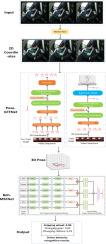3D skeleton aware driver behavior recognition framework for autonomous driving system
IF 5.5
2区 计算机科学
Q1 COMPUTER SCIENCE, ARTIFICIAL INTELLIGENCE
引用次数: 0
Abstract
The recognition of the driver’s behaviors inside an autonomous vehicle can effectively address emergency handling in autonomous driving and is crucial for ensuring the driver’s safety. Driver behavior recognition is a challenging task due to factors such as variations, diversities, complexities, and strong interferences in behaviors. In this paper, to realize the application in the autonomous driving scenes, a novel 3D skeleton aware behavior recognition framework is proposed to recognize various driver behaviors in autonomous driving systems. First, a 3D human pose estimation network (Pose-GTFNet) with temporal Transformer and spatial graph convolutional network (GCN) is designed to infer 3D human poses from 2D pose sequences. Second, based on the obtained 3D human pose sequences, a behavior recognition network (Beh-MSFNet) with multi-skeleton feature fusion is designed to recognize driver behaviors. In the experiments, the Pose-GTFNet and Beh-MSFNet can get the best performance compared with most state-of-the-art (SOTA) methods on the Human3.6M human pose dataset, JHMDB and SHREC action recognition dataset, respectively. In addition, the proposed driver behavior recognition framework can achieve SOTA performance on the Drive&Act and Driver-Skeleton driver behavior datasets.

用于自动驾驶系统的三维骨骼感知驾驶员行为识别框架
识别自动驾驶汽车内驾驶员的行为可以有效解决自动驾驶中的紧急处理问题,对确保驾驶员的安全至关重要。由于驾驶员行为的多变性、多样性、复杂性和强干扰性等因素,驾驶员行为识别是一项具有挑战性的任务。为了实现自动驾驶场景中的应用,本文提出了一种新颖的三维骨骼感知行为识别框架,用于识别自动驾驶系统中的各种驾驶员行为。首先,设计了一个包含时间变换器和空间图卷积网络(GCN)的三维人体姿态估计网络(Pose-GTFNet),用于从二维姿态序列推断三维人体姿态。其次,根据获得的三维人体姿态序列,设计了一个多骨架特征融合的行为识别网络(Beh-MSFNet)来识别驾驶员的行为。在实验中,Pose-GTFNet 和 Beh-MSFNet 分别在 Human3.6M 人体姿态数据集、JHMDB 和 SHREC 动作识别数据集上获得了与大多数先进方法(SOTA)相比最好的性能。此外,所提出的驾驶员行为识别框架还能在 Drive&Act 和 Driver-Skeleton 驾驶员行为数据集上实现 SOTA 性能。
本文章由计算机程序翻译,如有差异,请以英文原文为准。
求助全文
约1分钟内获得全文
求助全文
来源期刊

Neurocomputing
工程技术-计算机:人工智能
CiteScore
13.10
自引率
10.00%
发文量
1382
审稿时长
70 days
期刊介绍:
Neurocomputing publishes articles describing recent fundamental contributions in the field of neurocomputing. Neurocomputing theory, practice and applications are the essential topics being covered.
 求助内容:
求助内容: 应助结果提醒方式:
应助结果提醒方式:


